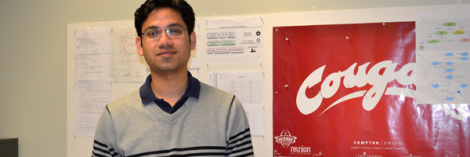
A Focus on Data
- Student Profile -
Barnan Das, Department of Computer Science
Research Focus: Computer Science, Machine Learning and Data Mining
- Research Profile -
Overview:
A by-product of the various research projects going on with the Smart Home is errors and issues with the statistical and analytical aspects of the data. Das focuses primarily on machine learning with regard to the Smart Home with the goal of solving issues in quality of life for those with health care needs, as well as advancing the functionality and efficiency of the Smart Home itself.
Research Focus:
Das’ application and target population are Alzheimer’s and dementia patients with an emphasis on elder populations.
Research Methodology:
In this boom of health care research, the fundamental purpose is to prevent disease and increase longevity of life. Dementia is a barrier to achieving this goal. The purpose of smart environments and mobile health care has two facets.
1) Gain data through the study of an individual’s lifestyle and daily habits — documenting their daily behavior and sharing the findings with healthcare providers. For example – a machine can maintain a daily tracking of a heartbeat. When that information is passed on to a physician, he or she would decipher the health of that heartbeat; whether there is a prediction of abnormality or disease.
2) Provide the individual in the smart home environment with the best communication tools possible so they are aided in managing activities properly, efficiently and safely. This is not limited to daily activities but also stems to overall health care management (i.e. reminders for doctor appointments or annual flu shots).
Das’ research focuses on the second facet…
“I’m trying to develop the systems that will interact with the individuals in smart homes and help them with their daily activities. What I do is try to develop learning techniques that tracks normal behavior of activities from a huge population. After identifying the normal behavior, I build a system that is able to predict an abnormal behavior if that takes place in a certain activity.”
EXAMPLE…
- Das has data from the sensors within the smart home environment for specific activities. For this example, the focus is on the task of cooking.
- He gathers data from 200 individuals
- There is a standard data set for how the cooking process should go – but there is a lot of variance because people’s homes differ, their time to do a tasks differs, they might have alternative ways of accomplishing tasks. Regardless, the basic underlying algorithm of cooking is the same.
- He builds a system that understands what ‘normal’ for cooking means and then applies the system in the real world that tracks the activities for other individuals.
- The sensors go to work and identify if a patient has skipped one of the main steps that may be crucial to that cooking task
- Das’ method will identify that specific point where the main task was skipped. It is assumed that every activity is composed of a number of tiny steps. When the individual misses a step – the system picks up on that specific point, interrupts the individual and prompts them to get back on track.
I have not yet gotten into the stage where the system can say that you have skipped a certain step but I can pick up on the time and know that the user has really skipped something and done something not normal for this certain activity.
Research Emphasis:
The emphasis for the prompting system is on smart phones but the framework is about the interaction of the sensors and data – something that has to be prompted – so the actual device could be a variety of tools.
This is the third study of its kind. The first study was with 400 MCI (Micomitave Impaired Patient), the second study was known as (PUNK) Prompting Users and Controlled Kiosk.
Das’ research consisted of 40 participants and he was primarily involved in writing the report, capturing data and managing the machine model. A partnership study is also underway related to Parkinson’s research that utilizes activities used in the PUNK studies graph.
